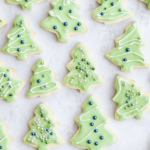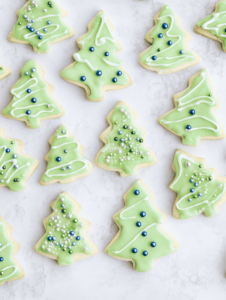There’s something undeniably comforting about biting into a perfectly baked sugar cookie. Old fashioned rolled sugar cookies are a classic treat that have graced kitchen tables and holiday platters for generations. With their crisp edges, soft centers, and delicate sweetness, these cookies are both simple and elegant. They evoke nostalgia, reminding us of cozy afternoons spent baking with loved ones.
The Timeless Appeal
What makes these cookies so enduringly popular? Perhaps it’s their versatility—they can be cut into any shape and decorated to suit any occasion. Maybe it’s the way they bring people together, creating cherished memories with each batch baked. Whatever the reason, old fashioned rolled sugar cookies remain a beloved favorite, capturing the essence of traditional home baking.
Historical Background of Sugar Cookies
Origins
The sugar cookie traces its roots back to the mid-1700s in Nazareth, Pennsylvania. German settlers created a simple, buttery, round cookie that came to be known as the Nazareth Sugar Cookie. Using basic ingredients like sugar, butter, eggs, and flour, these early cookies laid the foundation for the classic recipe we know today.
Evolution Over Time
As ingredients became more accessible and baking techniques evolved, so did the sugar cookie. Recipes adapted to include leavening agents like baking powder, resulting in a softer texture. The introduction of cookie cutters in the 1800s allowed for creative shapes and designs, making them a staple for holidays and special occasions.
Cultural Impact
Sugar cookies have become an integral part of American traditions. They are especially popular during festive seasons like Christmas and Halloween, where decorating them becomes a fun activity for families. The simplicity of the recipe makes it accessible to bakers of all skill levels, further cementing its place in culinary history.
The Art of Rolling Sugar Cookies
Importance of Rolling
Rolling the dough is a crucial step that affects the cookies’ texture and appearance. Achieving the perfect thickness ensures even baking, resulting in cookies that are crisp yet tender. Proper rolling also allows for intricate shapes using cookie cutters, making your creations both delicious and visually appealing.
Techniques
To roll your dough evenly, start from the center and work your way outwards, applying gentle, consistent pressure. Use a lightly floured surface and rolling pin to prevent sticking. For uniform thickness, consider using guide rings or thickness rails on your rolling pin.
Tools of the Trade
Investing in quality tools can make the process smoother. A non-stick rolling pin and a silicone baking mat can significantly reduce sticking. Additionally, adjustable rolling pins with thickness settings help achieve consistent results every time.
Ingredient Spotlight
Key Ingredients
Butter: Provides richness and flavor. Unsalted butter is preferred to control the salt content.
Sugar: Granulated sugar gives the cookies their signature sweetness and slight crispness.
Flour: All-purpose flour offers the right balance of structure and tenderness.
Eggs: Bind the ingredients together and add moisture.
Vanilla Extract: Enhances the flavor with a warm, sweet aroma.
Baking Powder: Acts as a leavening agent to give a slight rise.
Salt: Balances the sweetness and enhances other flavors.
Flavor Enhancers
While vanilla extract is traditional, you can experiment with almond extract or lemon zest for a unique twist. Spices like cinnamon or nutmeg can also add warmth and depth to your cookies.
Ingredient Preparation
Ensure all ingredients are at room temperature for smoother mixing. Measure accurately using measuring cups and spoons—baking is a science, and precision is key.
Ingredients List
Essential Ingredients
3 cups all-purpose flour
1 cup unsalted butter, softened
1 cup granulated sugar
1 large egg
1 teaspoon vanilla extract
1 teaspoon baking powder
1/2 teaspoon salt
Substitutions
Gluten-Free Option: Use a 1:1 gluten-free flour blend.
Dairy-Free Option: Substitute butter with a plant-based alternative.
Necessary Equipment
Baking Tools
Mixing bowls
Electric mixer or hand mixer
Measuring cups and spoons
Rubber spatula
Cookie-Specific Tools
Rolling pin
Cookie cutters
Baking sheets
Parchment paper or silicone baking mats
Optional Tools
Cooling racks
Guide rings for rolling pin
Step-by-Step Instructions
Step 1: Preparing the Dough
Creaming Butter and Sugar
In a large mixing bowl, beat the softened butter and granulated sugar together until light and fluffy. This should take about 2-3 minutes on medium speed. Creaming incorporates air, which helps create a tender cookie.
Adding Eggs and Vanilla
Add the egg to the butter-sugar mixture, mixing until fully incorporated. Then, blend in the vanilla extract. Scrape down the sides of the bowl as needed to ensure everything is well combined.
Mixing Dry Ingredients
In a separate bowl, whisk together the all-purpose flour, baking powder, and salt. Gradually add the dry ingredients to the wet mixture, mixing on low speed. Continue until the dough starts to come together and no dry flour remains.
Achieving the Right Consistency
The dough should be firm but pliable, not sticky. If it’s too soft, you can add a tablespoon of flour at a time until the desired consistency is reached. Avoid overmixing to prevent the cookies from becoming tough.
Step 2: Chilling the Dough
Why Chill?
Chilling solidifies the fat in the dough, which helps the cookies maintain their shape and prevents excessive spreading during baking. It also allows the flavors to meld together.
Chilling Methods
Divide the dough into two equal portions. Flatten each into a disk and wrap tightly in plastic wrap. Refrigerate for at least 1-2 hours or overnight for best results.
Step 3: Rolling Out the Dough
Preparation
Remove one disk of dough from the refrigerator and let it sit at room temperature for about 10 minutes. Lightly flour your work surface and rolling pin to prevent sticking.
Rolling Techniques
Roll the dough evenly to about 1/4 inch thickness. Start from the center and roll outward, rotating the dough occasionally to maintain an even shape.
Troubleshooting
If the dough cracks, let it warm slightly before rolling. If it’s too sticky, sprinkle a bit more flour on the surface and rolling pin.
Step 4: Cutting the Cookies
Choosing Cookie Cutters
Select cookie cutters that match your desired theme or occasion. Press the cutters firmly into the dough, ensuring clean edges.
Maximizing Dough Usage
Place cutters close together to minimize scraps. Gather leftover dough, re-roll, and continue cutting until all the dough is used.
Step 5: Baking the Cookies
Oven Preparation
Preheat your oven to 350°F (175°C). Line baking sheets with parchment paper or silicone baking mats.
Baking Process
Place the cut-out cookies about 1 inch apart on the prepared baking sheets. Bake for 8-10 minutes or until the edges are just beginning to turn golden.
Ensuring Even Baking
For consistent results, bake one sheet at a time in the center of the oven. If baking multiple sheets, rotate them halfway through the baking time.
Step 6: Cooling and Decorating
Cooling
Allow the cookies to cool on the baking sheet for 5 minutes. Transfer them to wire racks to cool completely before decorating.
Basic Decoration Ideas
For a simple finish, sprinkle granulated sugar over the cookies before baking. Alternatively, dust cooled cookies with powdered sugar for a delicate touch.
Decorating Techniques
Icing Recipes
Simple Royal Icing
2 cups powdered sugar
1-2 tablespoons milk
1 teaspoon vanilla extract
Food coloring (optional)
Mix powdered sugar with milk and vanilla extract until smooth. Adjust the consistency by adding more sugar or milk as needed.
Decoration Methods
Piping and Flooding
Use a piping bag to outline the cookies with icing. Then, fill the center (flooding) and use a toothpick to spread the icing evenly.
Adding Accents
Decorate with sprinkles, edible glitter, or colored sugars while the icing is still wet.
Theme Ideas
Customize your cookies for holidays or special events. Think snowflakes for winter, hearts for Valentine’s Day, or personalized messages for birthdays.
Expert Tips for Perfect Sugar Cookies
Avoid Overmixing
Mix the dough just until the ingredients are combined. Overmixing can develop gluten, leading to tougher cookies.
Temperature Matters
Baking in a cool kitchen helps prevent the dough from becoming too soft. If your kitchen is warm, consider chilling your tools and baking sheets.
Consistent Sizing
Use the same thickness and cutter sizes to ensure even baking. This prevents smaller cookies from burning while larger ones are undercooked.
Storage Suggestions
Store baked cookies in an airtight container at room temperature for up to a week. Place parchment paper between layers to prevent sticking.
Recipe Variations
Flavor Enhancements
Almond Extract: Substitute half of the vanilla extract with almond extract for a nutty flavor.
Citrus Zest: Add a teaspoon of lemon or orange zest to the dough for a fresh twist.
Dietary Adjustments
Gluten-Free: Use a gluten-free all-purpose flour blend.
Dairy-Free: Replace butter with a plant-based margarine.
Sugar Alternatives
Brown Sugar: Swap out half of the granulated sugar for brown sugar for a hint of molasses.
Powdered Sugar: Using powdered sugar in the dough can result in a softer, melt-in-your-mouth texture.
FAQs
Why Are My Sugar Cookies Tough?
Tough sugar cookies are often the result of overmixing the dough, which activates too much gluten. To avoid this, mix your ingredients until they’re just combined. Also, ensure you’re measuring your flour correctly; too much flour can make cookies hard. Use the spoon-and-level method rather than scooping directly from the bag.
How Can I Prevent Cookies from Spreading?
Chilling your dough thoroughly before baking helps prevent spreading. Additionally, avoid placing dough on warm baking sheets, and use parchment paper instead of greasing the pans. Make sure your butter isn’t too soft, and be cautious not to over-cream it with the sugar.
Can I Freeze the Dough or Baked Cookies?
Absolutely! To freeze the dough, wrap it tightly in plastic wrap and place it in a freezer-safe bag for up to three months. Thaw in the refrigerator before rolling out. Baked cookies can also be frozen; once cooled, layer them between sheets of parchment paper in an airtight container.
Conclusion
Baking old fashioned rolled sugar cookies is more than just making a sweet treat—it’s about embracing tradition and creating memories. Whether you’re an experienced baker or a novice in the kitchen, this timeless recipe offers a delightful way to connect with loved ones. So roll up your sleeves, preheat that oven, and start baking your own batch of nostalgia.
Print
Old Fashioned Rolled Sugar Cookies: A Timeless Recipe for Every Occasion
Description
Old fashioned rolled sugar cookies are a timeless classic that have delighted taste buds for generations. Originating from simple home kitchens, these cookies boast a delicate balance of buttery richness and subtle sweetness. With crisp edges and soft, tender centers, they’re perfect for any occasion—from everyday treats to festive holiday delights. Their versatile dough is easy to work with, allowing you to roll and cut it into various shapes, making them a favorite for both baking novices and seasoned pros.
Ingredients
- 3 cups all-purpose flour
- 1 cup unsalted butter, softened
- 1 cup granulated sugar
- 1 large egg
- 1 teaspoon vanilla extract
- 1 teaspoon baking powder
- 1/2 teaspoon salt
Instructions
- Cream the Butter and Sugar:
- In a large mixing bowl, use an electric mixer on medium speed to beat 1 cup softened unsalted butter and 1 cup granulated sugar together until the mixture is light and fluffy. This should take about 2-3 minutes.
- Add Egg and Vanilla:
- Add 1 large egg to the butter-sugar mixture, mixing until fully incorporated.
- Mix in 1 teaspoon vanilla extract, scraping down the sides of the bowl as needed to ensure everything is well combined.
- Combine Dry Ingredients:
- In a separate bowl, whisk together 3 cups all-purpose flour, 1 teaspoon baking powder, and 1/2 teaspoon salt until evenly mixed.
- Mix Dry and Wet Ingredients:
- Gradually add the dry ingredient mixture to the wet ingredients, mixing on low speed.
- Continue mixing until the dough starts to come together and no dry flour remains. Avoid overmixing to prevent tough cookies.
- Divide and Chill the Dough:
- Divide the dough into two equal portions.
- Flatten each portion into a disk shape and wrap tightly in plastic wrap.
- Refrigerate the dough disks for at least 1-2 hours, or overnight for best results.
- Preheat Oven and Prepare Baking Sheets:
- Preheat your oven to 350°F (175°C).
- Line baking sheets with parchment paper or silicone baking mats to prevent sticking.
- Roll Out the Dough:
- Remove one dough disk from the refrigerator and let it sit at room temperature for about 10 minutes to soften slightly.
- Lightly flour your work surface and rolling pin to prevent sticking.
- Roll the dough evenly to a thickness of about 1/4 inch.
- Cut Out Cookies:
- Use cookie cutters of your choice to cut out shapes from the rolled dough.
- Place the cut-out cookies about 1 inch apart on the prepared baking sheets.
- Bake the Cookies:
- Bake the cookies in the preheated oven for 8-10 minutes, or until the edges are just beginning to turn lightly golden.
- For even baking, rotate the baking sheet halfway through the baking time if necessary.
- Cool the Cookies:
- Remove the baking sheet from the oven and allow the cookies to cool on the sheet for 5 minutes.
- Transfer the cookies to a wire rack to cool completely before decorating.
- Repeat with Remaining Dough:
- Gather any leftover dough scraps, re-roll them, and continue cutting out shapes.
- Repeat the rolling, cutting, and baking process with the second dough disk.
- Decorate as Desired:
- Once the cookies are completely cooled, decorate them with icing, sprinkles, or any other desired toppings.
- Enjoy your homemade old fashioned rolled sugar cookies!


